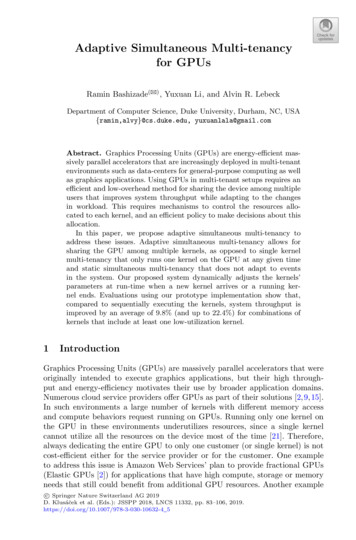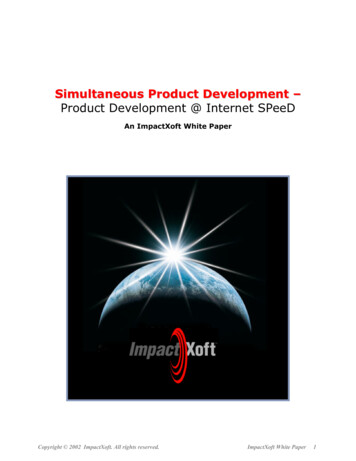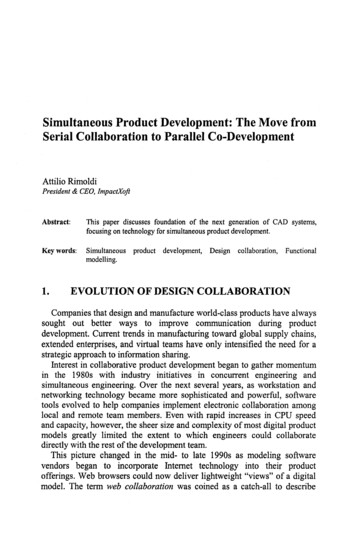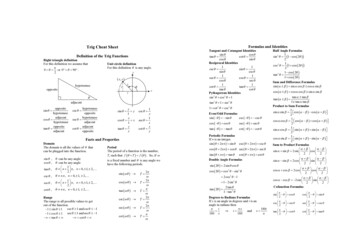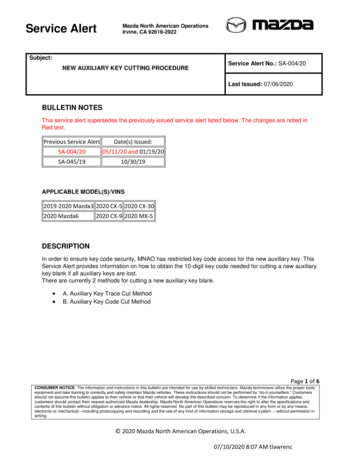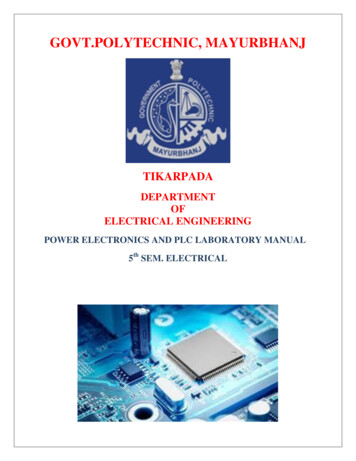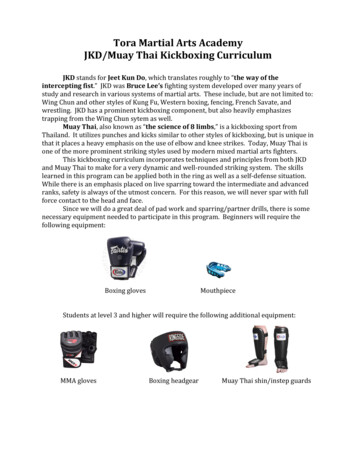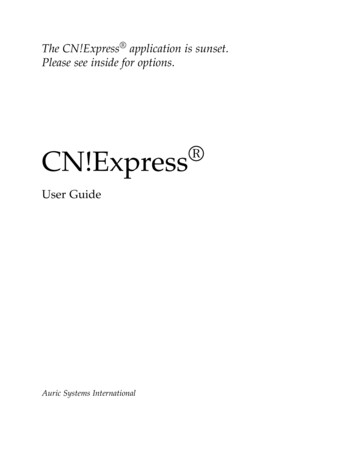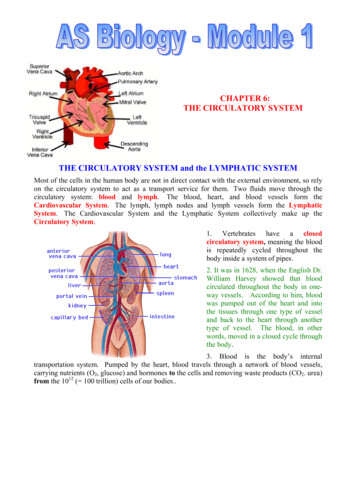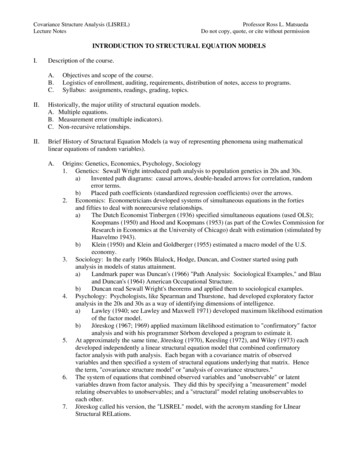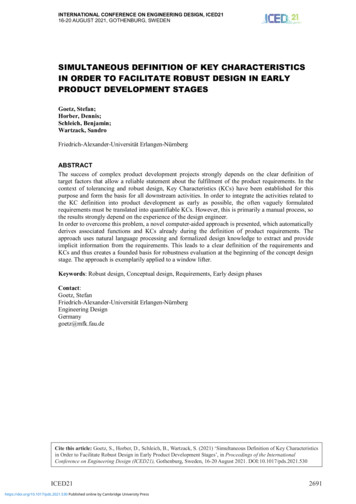
Transcription
INTERNATIONAL CONFERENCE ON ENGINEERING DESIGN, ICED2116-20 AUGUST 2021, GOTHENBURG, SWEDENSIMULTANEOUS DEFINITION OF KEY CHARACTERISTICSIN ORDER TO FACILITATE ROBUST DESIGN IN EARLYPRODUCT DEVELOPMENT STAGESGoetz, Stefan;Horber, Dennis;Schleich, Benjamin;Wartzack, SandroFriedrich-Alexander-Universität Erlangen-NürnbergABSTRACTThe success of complex product development projects strongly depends on the clear definition oftarget factors that allow a reliable statement about the fulfilment of the product requirements. In thecontext of tolerancing and robust design, Key Characteristics (KCs) have been established for thispurpose and form the basis for all downstream activities. In order to integrate the activities related tothe KC definition into product development as early as possible, the often vaguely formulatedrequirements must be translated into quantifiable KCs. However, this is primarily a manual process, sothe results strongly depend on the experience of the design engineer.In order to overcome this problem, a novel computer-aided approach is presented, which automaticallyderives associated functions and KCs already during the definition of product requirements. Theapproach uses natural language processing and formalized design knowledge to extract and provideimplicit information from the requirements. This leads to a clear definition of the requirements andKCs and thus creates a founded basis for robustness evaluation at the beginning of the concept designstage. The approach is exemplarily applied to a window lifter.Keywords: Robust design, Conceptual design, Requirements, Early design phasesContact:Goetz, StefanFriedrich-Alexander-Universität Erlangen-NürnbergEngineering DesignGermanygoetz@mfk.fau.deCite this article: Goetz, S., Horber, D., Schleich, B., Wartzack, S. (2021) ‘Simultaneous Definition of Key Characteristics1inICED21Order to Facilitate Robust Design in Early Product Development Stages’, in Proceedings of the InternationalConference on Engineering Design (ICED21), Gothenburg, Sweden, 16-20 August 2021. 017/pds.2021.530 Published online by Cambridge University Press2691
1INTRODUCTIONIn today's dynamic and competitive markets, an increasing demand for quality and complexity requiresa comprehensive but flexible definition of product requirements as starting point for productdevelopment. The diverse characteristics of the large number of requirements inevitably lead tounclear or ambiguous requirement definitions. Nevertheless, the technical realization calls for asuitable interpretation and their translation into appropriate target factors to fulfil customers' demands.In the context of robust design and tolerancing, these factors are usually called Key Characteristics(KCs) forming the basis for subsequent activities (Thornton, 2004). Even though their definition playsa crucial role in product development, it is usually a manual process, whose results strongly depend onthe design engineer's expertise. Especially in the context of a dynamic product development process,this step is time consuming and thus a hurdle for an early robustness evaluation of principal solutions.Therefore, this contribution presents a knowledge-based approach that utilizes natural languageprocessing (NLP) for the simultaneous derivation of functions and KCs during requirement definition.The paper is structured as follows. Section 2 discusses related work considering requirementsengineering and design evaluation in the context of early robust design. Based on the resultingresearch question in section 3, section 4 describes the proposed approach, which is exemplarilyapplied and discussed in section 5. Finally, the paper closes with a conclusion and an outlook.2RELATED WORKSince product development processes usually start with the definition of requirements, it has a decisiveinfluence on design decisions and their traceability. Thus, the requirements engineering including theidentification and unification of stakeholder requirements and their appropriate documentation andmanagement emerged. (Pohl, 2010) Due to the various sources of requirements and the progressiveconcretization along the product development process, there are several types (e.g. process or productrequirement) and levels of detail (Dick et al., 2017). For example, a strict distinction between wishes anddemands is drawn (Rupp, 2014). Apart from this characterization, the quality of the requirementdefinition particularly affects the product success (Kamata and Tamai, 2007). Thus, a properdocumentation of this various information is indispensable (Pohl, 2010). Besides a formal structureddocumentation, for example via UML or SysML, textual requirements in sentences, e.g. in requirementlists, are preferred in the design engineering context (INCOSE, 2017). In order to ensure a high quality,for example by avoiding redundant, unclear and ambiguous requirements (Dick et al., 2017), there areextensive writing guides leading to a proper wording of the requirement definition (INCOSE, 2017).However, ambiguities in requirements definition cannot be completely prevented by these guidelines,especially in large development teams. Thus, particularly in the context of software development, NLP isincreasingly used to systematically analyze, classify and improve the requirement definition (Nazir et al.,2017). This includes the elimination of ambiguities from text (Kiyavitskaya et al., 2008) and thetransformation into design artefacts (Yue et al., 2011). Despite extensive preliminary work in the area ofusing NLP for requirements engineering, the adaptation to individual contexts or applications is still partof ongoing research (Dalpiaz et al., 2018; Zhao et al., 2020).Once the requirements are properly defined, they are translated into specific design parameters in theongoing development process according to the Axiomatic Design (Suh, 1990). Thereby the House ofQuality (HoQ) from the Quality Function Deployment (QFD) facilitates the structured, matrix-basedmapping of the relations between requirements and design parameters (Sullivan, 1986). This breakdown constitutes a significant concretization of the product and is therefore often time-consuming.Nevertheless, this step is essential at the beginning of the product development process, especiallywith regard to a robust product design (Göhler et al., 2016). In this context these parameters, whichmap the requirements in a quantifiable way, are usually called Key Characteristics (KCs) (Thornton,2004). They are the basis for tolerancing and robust design activities and improve the traceability ofdesign decisions throughout the product development process (Zheng et al., 2008). Moreover, theyenable an early quantitative design evaluation and thus contribute to a largely objective conceptselection in the next step of product development (Okudan and Tauhid, 2008). Accordingly, aquantitative approach for the evaluation of principal solutions under consideration of differentrobustness principles was presented. The basis for this approach is the function structure of the productas well as the derived KCs, which are included in the evaluation with a weighting based on theVariation Risk Priority Number (VRPN) from a modified Variation Mode and Effect Analysis2692https://doi.org/10.1017/pds.2021.530 Published online by Cambridge University PressICED21
(VMEA). This leads to one individual robustness index for each principal solution enabling theconsideration of the aspect of robustness in the multi-criteria design evaluation at the beginning of theconcept design. (Goetz et al., 2019)3RESEARCH QUESTIONSummarizing the related work, the proper definition of requirements is crucial for successful productdevelopment and reliable design evaluations. Besides the formalization of the requirements, this callsfor a translation into design parameters enabling the concretization from implicit to explicit productinformation in the ongoing development process. However, there is a lack of specific approachessupporting the design engineer in this step. Thus, the actual linking of requirements and quantitativeparameters is often weak, which is a major burden especially in the concept evaluation (Okudan andTauhid, 2008). Accordingly, the results of the robustness evaluation of principal solutions significantlydepend on the requirement-based definition of KCs and thus on the experience as well as the effort ofthe respective design engineer. Consequently, motivated by the demand for a more reliable andaccelerated derivation of KCs the following research question arises: How can ambiguities in thedefinition of criteria for robustness evaluation in early design stages be consistently reduced?4SIMULTANEOUS DEFINITION OF KEY CHARACTERISTICSIn the common procedure, requirements are sequentially broken down to specific KCs, see Figure 1.However, this one-way procedure is subjective and leads to time-consuming iterations in case ofrequirement changes. In contrast, the proposed approach enables a simultaneous definition ofrequirements, functions and KCs fostering a better linkage, see Figure 1. Moreover, the utilization ofNLP and formalized design knowledge enables an automatic classification of requirements leading toa clear understanding of the intention of the requirement and a computer-aided derivation of functions,KCs and their attributes. The classification uses the classes necessity (wish/demand), aspect(qualitative/quantitative) and condition (hurdle/optimization) defined in preliminary work (Horber etal., 2019). Since this classification focuses on the automated derivation of evaluation criteria (Horberet al., 2020), it is reasonable for the intended robustness evaluation.common sequential procedurerequirementsfunctionssimultaneous onclassificationNLP designknowledgeKCsrobustness evaluationFigure 1. Transition from sequential to simultaneous KC definitionAfter a brief introduction of the corresponding workflow shown in Figure 2, the principles of theapproach are explained in detail in the subsequent paragraphs. The process starts with an initialrequirement definition, which is automatically classified revealing what is commonly meant by thisspecific requirement. This enables a stringent adaption of the wording by the design engineer so thatthe actual intention becomes clear. Simultaneously, the automatic derivation of function and KCproposals with associated attributes such as target values and directions of improvement takes place.The adoption of the function proposals and the corresponding weighting with respect to the relevancefor the associated requirement leads to a proper function definition influencing the derived KCs. Theiradapting and weighting according to the VMEA presented by Goetz et al. (2019) completes thesimultaneous definition of KCs. Finally, the results from the proposed approach are unified in onecommon modified HoQ including requirements, functions, KCs and the corresponding weightings andrelations. This documentation of relevant information for a specific product allows a comprehensiveconsistency check that helps to avoid redundant or ambiguous definitions. Moreover, it forms the basisfor the robustness evaluation of principal solutions according to Goetz et al. (2019).ICED21https://doi.org/10.1017/pds.2021.530 Published online by Cambridge University Press2693
refinement*requirementrequirement levelclassificationfunction level*functions with weightingderived function proposalsKC level*derived KC proposalswith attributesKCs with properties andweighting from VMEA*func.functions, KCs incl.attributes and weightingsKCsreq.unifiedHoQusage &documentationrobustnessevaluationFigure 2. Workflow of simultaneous function and KC definition and its documentation.Pictograms indicate automated steps and design engineer interaction. Simultaneous stepsare marked with an asterisk.The automated approach is based on fundamental NLP features shown in Figure 3. In combinationwith rule-based matching (Nadkarni et al., 2011) this allows the integration of formalized semanticdesign knowledge that is especially necessary in case of less specific requirements. In order to cover awide range of requirements with different level of detail, the proposed approach combines variousprinciples. These different aspects and their realization are explained below by means of three typesof requirements with decreasing information content.tokenization – segmenting textPart-of-Speech taggingdependency parsinglemmatization – base form of wordsFigure 3. Explanation of basic NLP features (generated with spaCy)Requirement with direct description of KCIn order to identify this requirement type, it is first compared with the appropriate defined KC listincluding the terms gap, flush, distance, clearance, angle, tilt and tilting commonly used for theexplicit description of KCs. In combination with dependency parsing, this allows the extraction of theKC including the corresponding components, see Figure 4.direction of improvement& quality loss functionwordcompletionKCclassificationwish / demandclassificationhurdle /optimizationclassificationqualitative /quantitativeThe gap between window and frame must be 1mmrule-based matching (KC tag list& dependency parsing)Part-of-Speechtagging NOUNlemmatization &necessity tag listconditiontag listPart-of-Speechtagging NUMFigure 4. Extracted information (upper section) and corresponding techniques (lowersection) for exemplary direct requirement definition2694https://doi.org/10.1017/pds.2021.530 Published online by Cambridge University PressICED21
Furthermore, the identification of nouns within the requirement specification enables the realization ofa word completion approach. This accelerates the subsequent definition of further requirements andensures consistent word usage.Based on the fundamental idea described in (Horber et al., 2020) the proposed extension of theclassification of requirements allows a detailed derivation of the requirements intention. First, theexistence of a numeric modifier (NUM) in a requirement indicates whether it is qualitative orquantitative. The distinction between wish and demand is realized by matching the lemma of theverb assigned to the KC with a tag list. Thereby terms like should, could, can or might indicate wisheswhile the words must, need to, have to, shall or may describe a demand. Moreover, the tag list inFigure 5 enables a classification in hurdle and optimization. This helps to distinguish whether arequirement respectively evaluation criteria is already completely fulfilled by exceeding or fallingbelow a threshold value (hurdle) or whether further improvements are useful (optimization). Eventhough this classification is beneficial in the design evaluation process (Horber et al., 2020), detailedinformation about the desired behavior of a product under variation is missing. Therefore, the table inFigure 5 additionally provides quality loss functions (Phadke, 1989) that are commonly used in thecontext of robust design. They enable a proper evaluation of design alternatives during the deviationand robust design analysis in the subsequent product development steps. Finally, the derivation of thedirection of improvement allows its proper documentation in the HoQ (Sullivan, 1986).tagsconditionlarger, greater, more, at least,hurdleminimum, minimalshorter, smaller, fewer, less, athurdlemost, maximum, maximaldirection of improvementquality loss functionlossmaximizeKClossminimizeKCloss , , KCloss , as possible, equaloptimizationKCtargetloss , , KClosscombination of "maximize"and "minimize"KCFigure 5. Condition tag list with corresponding condition, direction of improvement andquality loss functionRequirement with indirect description of KCBesides the direct definition of KCs with corresponding target values, requirements often provide anindirect description of KCs. Therefore, a correct interpretation and transfer into an explicit definition isessential. Unlike the mostly manual and individual procedures, the proposed approach utilizessemantic and formalized knowledge for terms that are typically used. Figure 6 shows an extract ofthese tags with corresponding information.tagsparallelperpendicular, rectangularcoincident, concentricKC termangledisplacementtarget value0 90 0mmFigure 6. Exemplary tag list indicating KCs and target valuesThus, for example, the requirement "The horizontal gap between window and frame must be asparallel as possible" leads to a proposed KC angle gap window frame with target value 0 .Furthermore, in combination with the principles shown in the previous paragraph, the requirement isautomatically classified and further attributes, such as the direction of improvement, are derived.Requirement defining a functionFinally, requirements often refer to specific functions of a product. Since a direct link to KCs is notapparent, these requirements are frequently disregarded during the prevailing manual determination ofKCs. However, to ensure these functions, specific KCs must be observed. Thus, a 021.530 Published online by Cambridge University Press2695
approach, which automatically and uniformly derives associated KCs, is beneficial to ensure thatimplicitly necessary KCs are considered in further development. As the excerpt in Figure 7 shows, alargely universally valid knowledge base is generated with the aid of engineering design logic andformalized empirical knowledge. For example, the function seal is usually associated with a gap,which should be kept to a minimum if possible.verbguideKC termclearancedirection of improvementminimizesealgapminimizenot jamclearancemaximizeFigure 7. Exemplary tag list for functions with correspond. KC and direction of improvementFor instance, the requirement "The window must seal" stringently leads to the function seal window,the KC gap, the direction of improvement minimize and the corresponding quality loss function.Thus, the proposed approach classifies requirements with varying degrees of detail and automaticallyderives associated functions and KCs with the respective attributes. Finally, KCs are broken down intoindividual KCs according to the six degree of freedom (DOF), which allows a separate consideration inthe subsequent steps. For example, a distinction between translational and rotational clearance is useful.The documentation of these abstracted KCs in the unified HoQ enables an easy check for redundant KCsand thus helps to avoid ambiguous definitions. Moreover, motivated by the contradiction analysis forfunctional requirements (Göhler and Howard, 2015), conflicting KCs and thus requirements are simplyavoided or combined by considering the direction of improvement and the target value for multipledefined KCs in the extended HoQ. For better traceability and easy identification of weak points, therelations are additionally represented in a graph, see the exemplary excerpt in Figure 8.The gapshould be 0mm.requiresKC: gapwindowframerequiresThewindowmustseal.Figure 8. Exemplary graph with multiple definition of a KC5APPLICATIONThe proposed approach is exemplarily applied to a simplified electric car window regulator todemonstrate the practical workflow. This academic case study is industry-oriented and offers variousconcept alternatives such as the cross-arm or dual rail cable mechanism enabling a useful robustnessevaluation (Goetz et al., 2020). Moreover, the adequate simplicity of the system allows for goodcomprehensibility. The requirements listed below are exemplarily defined and do not claim to becomprehensive. They are partly redundant or ambiguous and formulated in different detail, see forexample requirement 3 and 5. This initial definition is the starting point for the application of theapproach.1.2.3.4.5.6.7.8.9.The window shall be guided properlyThe window should close quicklyThe window must sealThe window must be firmly attached to the mechanismThe gap between window and frame must be 1mmThe window must not jamThe window must not transfer excessive tensionThe gap between window and frame must be 0mmThe horizontal gap between window and frame must be as parallel as possible5.1 ImplementationThe conceptual implementation is based on spaCy, which is an open-source library enabling NLP.Figure 9 shows the prototype of the associated graphical user interface (GUI). In compliance with the2696https://doi.org/10.1017/pds.2021.530 Published online by Cambridge University PressICED21
structure of the workflow presented in Figure 2, the GUI is organized in three levels: requirement,function and KC. Consequently, the information belonging to an individual requirement issummarized in one single view.Figure 9. Prototype of GUI combining requirement, function and KC levelIn the first step, the respective requirement is initially defined by the user, processed in the backendvia NLP and automatically classified. If necessary, the design engineer can further specify therequirement so that the actual intention becomes clear and matches his understanding. Modificationsof the requirements directly affect the resulting proposals for functions and KCs.In the center of the GUI in Figure 9, the associated functions are simultaneously defined. The designengineer has the option to adopt and modify the automatically generated proposals. In order to avoidredundancy in the definition of further requirements, a comparison with the entries of the HoQidentifies if the function has already been determined. Finally, the design engineer is asked to weightthe respective functions with values between 0 and 1 reflecting its relative importance for the superiorrequirement. This corresponds to the entries of the relation matrix of the HoQ and forms the basis forthe structured robustness evaluation (Goetz et al., 2019).In the lower section, KCs are defined based on the proposed KCs including the correspondingdirections of improvement and, if applicable, the target values. According to the information from thetag list in Figure 7, clearance for all six DOF is proposed, see Figure 9. The proposal also respects thecheck for already specified redundant or conflicting definitions. Since the design engineer consideredthe clearance γ as irrelevant, five KCs associated with the requirement are determined. Finally, theseKCs are weighted using the modified VMEA (Goetz et al., 2019). This includes the assessment of theimportance (I) of the KC for the superior function or requirement, its probability (P) of variation and,if applicable, a correction(C) factor.This process is repeated for each requirement. The information, which is defined in the GUI, is stored inan Excel-based HoQ, see Figure 10. This comprises all requirements, the associated functions as well asKCs and forms the basis for the proposed consistency check. Thus, for example, the two requirements"The window shall be guided properly" and "The window must not jam" were merged because they havea similar intention, which results in the derivation of the same functions and KCs. However, since thedirection of improvement of the KCs for guide and not jam is opposing (see Figure 7), their 530 Published online by Cambridge University Press2697
led to a new quality loss function, see Figure 5. This proposed consistency check enabled the eliminationrespectively combination of two requirements and seven KCs for the case study presented here.Moreover, the HoQ shows the interrelations. The roof of the HoQ represents the relations amongfunctions and KCs. The relation matrix in the center shows the relative importance of the functions andthe resulting product of I, P and C from the GUI. The multiplication of these values in the relation matrixaccording to the relations defined in the roof results in the VRPN indicating the importance of the KC forthe entire product. This allows their easy prioritization for the subsequent product development steps. Clearance zClearance alphaClearance betaThe window shall be guided properlyClearance yRequirementsClearance xFunctions,Subfunctions,KCsGuide windowDirection of RPN (Technical Importance)Relative WeightFigure 10. Extract from unified HoQ for requirement 1 with information defined in the GUIdegree of constraint 3number ofparameters2Key Charakteristic - KCclear αclear βgapangle gap8080808060cross arm122222040dual rail111211380cross arm122211240dual rail12111920qual. lossVRPNØ-dual railclear zØ-cross armcriteriaFM -valuesBerechnenCalculateweightingInputInput- HoQ -VRPNThus, the HoQ forms the basis for the Excel-based robustness evaluation matrix shown in Figure 11.The information adopted from the previous steps are highlighted in blue. Consequently, the task of thedesign engineer is reduced to the concept evaluation regarding different robustness criteria in thecenter of the evaluation matrix. In contrast to the procedure described in (Goetz et al., 2019), thedesign engineer is supported by additionally derived information such as quality loss functions and, ifapplicable, target values. The detailed process of robustness evaluation is extensively described in(Goetz et al., 2019). So, the exemplary evaluation in Figure 11 does not claim to be comprehensiveand is primarily used for demonstrating the benefit of the proposed approach here. Based on theresulting indices, the principal solution dual rail cable window regulator is more robust than the crossarm window regulator (Goetz et al., 2020).5.43803.63.32.4product - functions (guide & move window)coupling2cross arm36dual rail12-62robustness index (cross arm) 14.7robustness index (dual rail)8Figure 11. Robustness evaluation matrix for two window lifter concepts2698https://doi.org/10.1017/pds.2021.530 Published online by Cambridge University PressICED21
5.2 DiscussionAs the matrix in Figure 11 shows, the robustness evaluation is simplified by the information providedby the proposed approach. Although the evaluation criteria are automatically provided, the results stilldepend on the designers' experience. However, the remaining ambiguity in the definition of thesecriteria is reduced by the additional available information, such as the quality loss functions. Thus, theresearch question is answered by using NLP and tag lists with semantically linked design knowledgederiving implicit information from the requirements. Therefore, the requirement definition mustfollow rules. This issue is countered by the semantic analysis of the requirements, which extracts theirintention e.g. by classification. Thus, the intended interaction with the design engineer stringentlyimproves the requirement definition and leads to a uniform understanding, without automatic changesof the input. The proposed approach uses rule-based NLP, in which the information associated with arequirement is explicitly mapped. As typical for knowledge-based approaches, there is a contradictionbetween the degree of detail and the universal applicability of the formalized design knowledge in thetag lists. Its extent depends on the scope and unambiguity of the requirement definition. Especiallywithin a company with recurring requirements, it allows comprehensive automation. However,confirmation by the design engineer is essential at this early stage, where the design space is extensive.The simultaneous NLP-supported definition of requirements, functions and KCs reveals intensions andrelations so that together with the designer's interaction a consistent definition can be ensured. Thisclarity, as well as the linked documentation, is particularly beneficial for complex products withnumerous interacting requirements or dynamic changes, as their impact is immediately clear.However, the degree of automation, especially in the derivation of implicit information, depends onthe formalized knowledge and the level of detail of the requirement definition.6CONCLUSION AND OUTLOOKThe contribution stresses the lack of specific computer-aided approaches supporting the designengineer in the translation of differently formulated requirements into quantifiable KCs, which are thebasis for tolerancing and robust design decisions. Since these KCs are the only quantitative criterionavailable for robustness evaluation at the beginning of the conceptual design, their clear definition isessential. Thus, the novel approach fosters the simultaneous definition of requirements, functions andKCs supported by the semantic analysis and derivation of information from the requirements. Theimplicitly available information is translated into concrete specifications with the help of NLP, rulesand formalized design knowledge. Besides, the classification of the requirements contributes to a clearunderstanding of their meaning. Thus, the unambiguity and quality of the requirement is consistentlyimproved. Furthermore, the comprehensive semantic analysis does not only derive functions and KCsbut also additional information such as associated quality loss functions. This extended informationsupports the design engineer in the subsequent robustness evaluation.Moreover, the approach provides an intensive linkage between requirements, functions and KCs,which enhances traceability of the effect of requirement changes. These relations are documented in anextended HoQ unifying the relevant information. The common document enables a consistency checkalready during the definition of requirements, which prevents redundant or contradicting requirementsand KCs. Finally, the HoQ also covers the weightings of the functions and KCs regarding theirimportance for the entire product so that all input variables relevant for the robustness evaluation ofconcepts are available. Apart from the improvement of the applicability of the early robustnessevaluation, the proposed appr
Since product development processes usually start with the definition of requirements, it has a decisive influence on design decisions and their traceability. Thus, the requirements engineering including the . 4 SIMULTANEOUS DEFINITION OF KEY CHARACTERISTICS In the common procedure, requirements are sequentially broken down to specific KCs .
